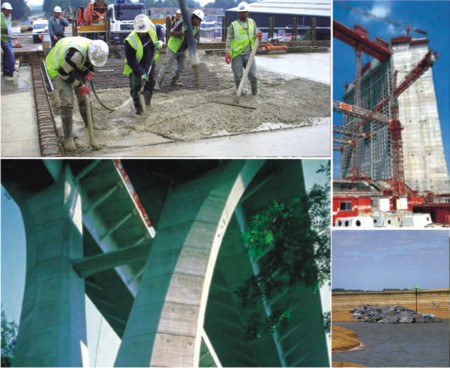Steel Fibre Concrete Composites for Special Applications

Normal and High Volume Steel Fibre Concrete Composites for Special Applications
Steel Fibre Reinforced Concrete (SFRC)
Concrete is the most widely used structural material in the world with an annual production of over seven billion tons. For a variety of reasons, much of this concrete is cracked. The reason for concrete to suffer cracking may be attributed to structural, environmental or economic factors, but most of the cracks are formed due to the inherent weakness of the material to resist tensile forces. Again, concrete shrinks and will again crack, when it is restrained. It is now well established that steel fibre reinforcement offers a solution to the problem of cracking by making concrete tougher and more ductile. It has also been proved by extensive research and field trials carried out over the past three decades, that addition of steel fibres to conventional plain or reinforced and prestressed concrete members at the time of mixing/production imparts improvements to several properties of concrete, particularly those related to strength, performance and durability.The weak matrix in concrete, when reinforced with steel fibres, uniformly distributed across its entire mass, gets strengthened enormously, thereby rendering the matrix to behave as a composite material with properties significantly different from conventional concrete.
The randomly-oriented steel fibres assist in controlling the propagation of micro-cracks present in the matrix, first by improving the overall cracking resistance of matrix itself, and later by bridging across even smaller cracks formed after the application of load on the member, thereby preventing their widening into major cracks (Fig. 1).
The idea that concrete can be strengthened by fibre inclusion was first put forward by Porter in 1910, but little progress was made in its development till 1963, when Roumaldi and Batson carried out extensive laboratory investigations and published their classical paper on the subject. Since then, there has been a great wave of interest in and applications of SFRC in many parts of the world. While steel fibres improve the compressive strength of concrete only marginally by about 10 to 30%, significant improvement is achieved in several other properties of concrete as listed in Table 1. Some popular shapes of fibres are given in Fig.2.
In general, SFRC is very ductile and particularly well suited for structures which are required to exhibit:
The behavior of SFRC under fatigue loading regime as compared to conventional concrete is shown in Fig. 3, while Fig. 4 illustrates the improvement in impact resistance of SFRC with the increase in the fibre content. The high ductility exhibited by normal SFRC and polymer-impregnated SFRC over conventional concrete is shown in Fig. 5.Resistance to impact, blast and shock loads and high fatigue- Shrinkage control of concrete (fissuration)
- Very high flexural, shear and tensile strength
- Resistance to splitting/spalling, erosion and abrasion
- High thermal/ temperature resistance
- Resistance to seismic hazards.
The degree of improvement gained in any specific property exhibited by SFRC is dependent on a number of factors that include:
- Concrete mix and its age
- Steel fibre content
- Fibre shape, its aspect ratio (length to diameter ratio) and bond characteristics.
Mix Design for SFRC
Just as different types of fibres have different characteristics, concrete made with steel fibres will also have different properties.When developing an SFRC mix design, the fibre type and the application of the concrete must be considered. There must be sufficient quantity of mortar fraction in the concrete to adhere to the fibres and allow them to flow without tangling together, a phenomenon called ‘balling of fibres’ (Fig. 6). Cement content is, therefore, usually higher for SFRC than conventional mixes Aggregate shape and content is critical. Coarse aggregates of sizes ranging from 10 mm to 20 mm are commonly used with SFRC. Larger aggregate sizes usually require less volume of fibres per cubic meter.
Thanks for sharing such a nice information . Lots of people will get benifited from your site. :) you can also visit Precision Drawell's website for Steel Fibre.
ReplyDeleteThanks for sharing a wonderful post about the steel fibre concrete. In every construction work most of peoples uses this Concrete process.
ReplyDelete